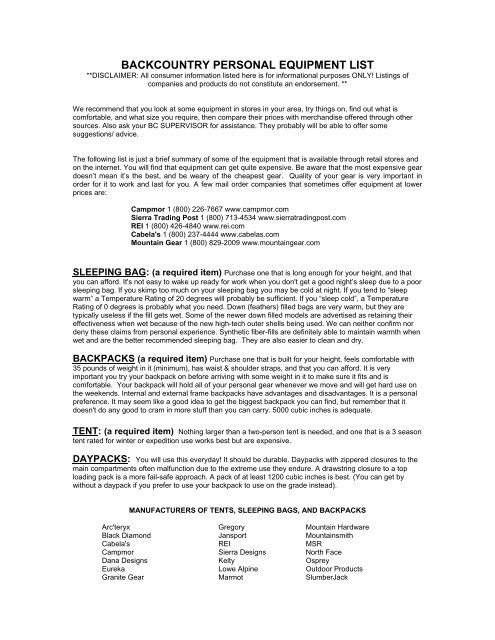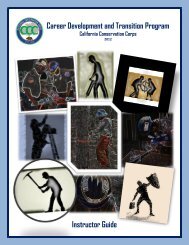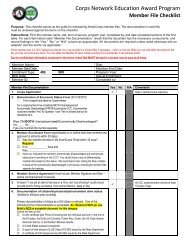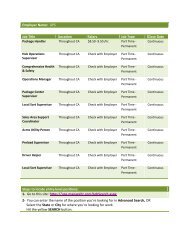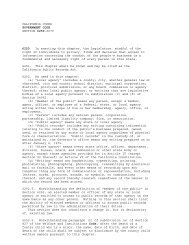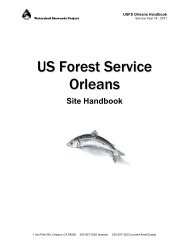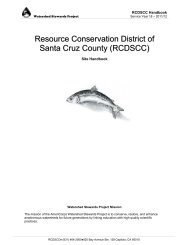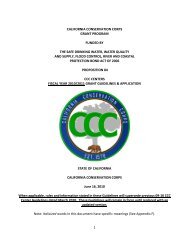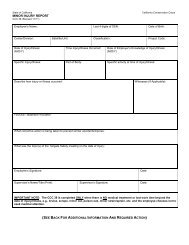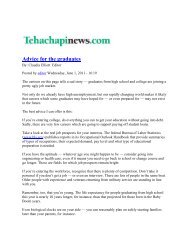BACKCOUNTRY PERSONAL EQUIPMENT LIST
BACKCOUNTRY PERSONAL EQUIPMENT LIST
BACKCOUNTRY PERSONAL EQUIPMENT LIST
- No tags were found...
Create successful ePaper yourself
Turn your PDF publications into a flip-book with our unique Google optimized e-Paper software.
<strong>BACKCOUNTRY</strong> <strong>PERSONAL</strong> <strong>EQUIPMENT</strong> <strong>LIST</strong>**DISCLAIMER: All consumer information listed here is for informational purposes ONLY! Listings ofcompanies and products do not constitute an endorsement. **We recommend that you look at some equipment in stores in your area, try things on, find out what iscomfortable, and what size you require, then compare their prices with merchandise offered through othersources. Also ask your BC SUPERVISOR for assistance. They probably will be able to offer somesuggestions/ advice.The following list is just a brief summary of some of the equipment that is available through retail stores andon the internet. You will find that equipment can get quite expensive. Be aware that the most expensive geardoesn’t mean it’s the best, and be weary of the cheapest gear. Quality of your gear is very important inorder for it to work and last for you. A few mail order companies that sometimes offer equipment at lowerprices are:Campmor 1 (800) 226-7667 www.campmor.comSierra Trading Post 1 (800) 713-4534 www.sierratradingpost.comREI 1 (800) 426-4840 www.rei.comCabela's 1 (800) 237-4444 www.cabelas.comMountain Gear 1 (800) 829-2009 www.mountaingear.comSLEEPING BAG: (a required item) Purchase one that is long enough for your height, and thatyou can afford. It's not easy to wake up ready for work when you don't get a good night’s sleep due to a poorsleeping bag. If you skimp too much on your sleeping bag you may be cold at night. If you tend to “sleepwarm” a Temperature Rating of 20 degrees will probably be sufficient. If you “sleep cold”, a TemperatureRating of 0 degrees is probably what you need. Down (feathers) filled bags are very warm, but they aretypically useless if the fill gets wet. Some of the newer down filled models are advertised as retaining theireffectiveness when wet because of the new high-tech outer shells being used. We can neither confirm nordeny these claims from personal experience. Synthetic fiber-fills are definitely able to maintain warmth whenwet and are the better recommended sleeping bag. They are also easier to clean and dry.BACKPACKS (a required item) Purchase one that is built for your height, feels comfortable with35 pounds of weight in it (minimum), has waist & shoulder straps, and that you can afford. It is veryimportant you try your backpack on before arriving with some weight in it to make sure it fits and iscomfortable. Your backpack will hold all of your personal gear whenever we move and will get hard use onthe weekends. Internal and external frame backpacks have advantages and disadvantages. It is a personalpreference. It may seem like a good idea to get the biggest backpack you can find, but remember that itdoesn't do any good to cram in more stuff than you can carry. 5000 cubic inches is adequate.TENT: (a required item) Nothing larger than a two-person tent is needed, and one that is a 3 seasontent rated for winter or expedition use works best but are expensive.DAYPACKS: You will use this everyday! It should be durable. Daypacks with zippered closures to themain compartments often malfunction due to the extreme use they endure. A drawstring closure to a toploading pack is a more fail-safe approach. A pack of at least 1200 cubic inches is best. (You can get bywithout a daypack if you prefer to use your backpack to use on the grade instead).MANUFACTURERS OF TENTS, SLEEPING BAGS, AND BACKPACKSArc'teryx Gregory Mountain HardwareBlack Diamond Jansport MountainsmithCabela's REI MSRCampmor Sierra Designs North FaceDana Designs Kelty OspreyEureka Lowe Alpine Outdoor ProductsGranite Gear Marmot SlumberJack
SLEEPING PAD: A pad that acts as a mattress for comfort and warmth (closed cell foam type orthermarest). Thermarests can be heavy and may puncture during the season. Foam sleeping pads are lightand very durable.WATER BOTTLE OR HYDRATION SYSTEM: Crewmembers should have a minimum ofone gallon of water carrying capacity and it is common to consume two gallons of water in a day. The newhydration systems, with a bladder connected to a tube that can be sipped from while hiking, are popularamong many trail workers. Even still, these do not typically have the capacity to carry a days worth of water,so bottles for refilling are necessary. One final note, water bottles can be relatively expensive so a low costalternative can be 2-liter soda type bottles (2 to 4 individual bottles provide approximately 1 to 2 gallons ofcarrying capacity). Soda bottles are reasonably durable and can be rigged using duct tape and parachutecord for increased durability as well as with loops for lashing and/or hanging the bottles.POCKETKNIFE: Almost any small folding knife will do. (Blades less than 4 inches). “Rambo” knivesare heavy and impractical for the simple tasks required of them. The multi-tool types of pocket knife (whichusually include a pliers among other accessories) are very useful and popular. Choose either to bring aknife OR a multi-tool, not both.FLASHLIGHT OR HEAD LAMP (with extra bulb and batteries): Many preferheadlamps. Flashlights tend to be impractical and heavy.ALARM CLOCK: A watch with an alarm will suffice, or a small travel alarm clock.STAMPS/ENVELOPES/PEN/PENCIL/PAPERSEWING KIT: A small personal sized kit or just a few needles with a spool of thread.<strong>PERSONAL</strong> TOILETRIES AND MEDICATION:1. Prescription medicines, extra pair of glasses, contact lenses, etc. - adequate supply for the season.2. Sunscreen3. Toothbrush / toothpaste4. Soap / Shampoo (Organic / Biodegradable)5. Towel (Light weight or backpacking towel)6. Comb / brush<strong>PERSONAL</strong> IDENTIFICATION: Drivers license, Passport, State Identification CardREQUIRED CLOTHING:1. Socks-- These are the key item of clothing in your life after providing for your warmth. Wool orpolypropylene are best for keeping warm even when wet, but both types can be too warm for some peoplein hot weather. Wool and polypropylene can be relatively expensive. Cotton are cold when wet and they alsoprovide the least padding, but they are also the least expensive. Five pair is a minimum quantity and ten pairis recommended.2. Underwear-- Five to seven pair is recommended.3. Warm Shirt-- A flannel or wool shirt can be a good option for layering.4. Sweater (Fleece or polypropylene) -- Another good option for layering.5. T-shirts-- Two to five are recommended.6. Warm Jacket or Parka-- A fleece or wool, medium weight jacket are recommended for maintainingwarmth when wet as well as being light enough to facilitate layering.7. Long and Short pants-- Uniforms provided by the CCC are the best option for long pants. At most, oneextra pair of long pants is recommended. One or, at most, two pairs of short pants are recommended forweekend hiking.
8. Swim suit-- One suit is sufficient.9. Beanie (wool or fleece) -- Maintaining head warmth is crucial in cold weather.10. Uniform pants (3 pairs) -- These are provided by the CCC.11. Uniform shirts (3 shirts) -- These are provided by the CCC.12. Rain Gear (You can use CCC-provided raingear or buy a good quality coated nylon type. Gore-Tex isexpensive and doesn't work well. Ponchos don't work).13. Boots (one pair of boots will be supplied but you should have another back up pair).OPTIONAL ITEMS: The following list includes everything you could ever want in the Backcountry.Choose wisely, picking only the items you anticipate needing, after careful thought about what your interestsare. Remember, you will have to carry everything you bring with you up steep mountain trails at highaltitudes, while hiking at a brisk pace. With gear, “Less is more!”1. Camera & Film w/ pre-paid mailers2. Fishing Gear (and fishing license)3. Camp footwear (Sneakers, sandals, or other comfortable shoes)*. A durable sport sandal that allows yourfeet to air out around camp can be very beneficial.4. Long Underwear (polypropylene) *5. Backpacking stove & cooking / eating gear6. Books / reading material (A library of resource books and other reading material is provided by the CCC.)REQUIRED SAFETY GEAR: These items are provided by the CCC and do not need to bepurchased. If you are in the CCC, bring your current gear with you.1. Hardhat2. Gloves (1 pair)3. Safety glassesNOTE1. Weapons of any type are illegal - don't bring any.2. Personal vehicles are not allowed. We do not have facilities for vehicle storage.3. You will be receiving a letter from your Backcountry Trail Crew Supervisor that will have additionalsuggestions.4. It is very helpful to have a contact person in civilization that would be willing to purchase and mailsupplies to you.5. Most crewmembers will be required to reduce personal gear to 35 pounds as the Season progresses.


